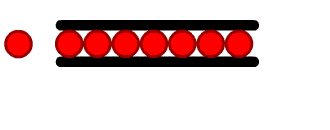A professor once told me that electrons moving from a light switch to a lightbulb move towards it at an average of about a millimeter-per-second, which means they take several hours to reach the bulb. But if that’s true, why does the light turn on instantly when I flip the switch?
The reason is that it’s the electric field, not the electrons themselves, that transfers energy. Just as north-poles of two magnets will repel each other via their magnetic fields, so will two electrons repel one-another via their electric fields. This repulsion propagates down the wire, with one group of electrons pushing another group of electrons, who in turn push more electrons…
As a popular analogy, imagine a long skinny tube, just wide enough to hold a ping-pong ball. This tube is completely filled from end-to-end with ping-pong balls. Once everything is set up in your head, imagine forcing another ping-pong ball into the tube at one end. Though the individual ping-pong balls will move only a small amount, the force of each ping-pong ball bumping into the next will propagate quickly all the way down the tube, and at the very end the final ping-pong ball will (almost) immediately be pushed out.

Propagating electric fields work in a similar manner, but the electrons are much smaller than ping-pong balls and there are many more of them flying around.
The all-too-common view that electrons are little packets of energy that are somehow created by batteries and "used up" by a lightbulb is completely false. In AC, the voltage continuously goes from positive to negative and back, so, much like someone on an inner tube in a wave-pool, the electrons simply move back and forth on the wire without ever going anywhere (this is why it doesn’t matter which way you plug things into the wall – for the most part). In both AC and DC, the energy comes from the movement of the electrons, not the electrons themselves.
Additional Reading:
- How is it possible that there’s not a complete circuit to the power plant?
- What’s the difference between “voltage at a point” and “voltage between two points?” Also, what is ‘ground?’
- What’s the difference between neutral and ground?
- Does electricity flow from positive (+) to negative (-) or from negative to positive?
- Why can the resistor go at the beginning of the circuit OR at the end?

